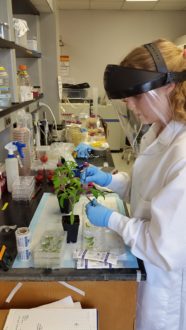Salmonella enterica is the most common cause of foodborne illness in the United States. Since Salmonella has been a food safety concern for vegetables produced on the Eastern Shore of Maryland with surface water and sediments identified as possible reservoirs for these bacteria, University of Maryland student Angela Ferelli conducted a Northeast SARE Graduate Student Grant project to better understand the food safety risks of Salmonella presence in irrigation water for vegetable crops.
Angela was particularly interested in learning about the ability of Salmonella to survive in irrigation water over time and its potential to transfer from water to crops. She collected water samples from local non-tidal rivers, tidal rivers, ponds, and reclaimed waste water sources, recorded their physicochemical characteristics (like pH, dissolved oxygen level, oxidation reduction potential, etc.), and inoculated them with several strains of Salmonella to assess bacteria survivability over a 90-day period.
To determine the potential of Salmonella transfer from water to vegetables, tomatoes were used as the study crop. Salmonella was inoculated into non-tidal fresh water samples that were then inoculated onto tomatoes and monitored over time.
Results suggested that Salmonella persistence in water was driven by water type. In her study, Angela found that Salmonella can enter into “viable but non-culturable” (VBNC) states in non-tidal fresh water samples as well as with some types of Salmonella enterica ( called “serovars”) in reclaimed wastewater and pond water samples. VBNC is one type of survival mode for Salmonella when it becomes stressed. Essentially, the bacteria becomes dormant or “sleeps” until environmental conditions (some of which are unknown) become ideal for its growth, making it more tricky to detect Salmonella levels in water.
She found that Salmonella transfer from water to tomato was driven by Salmonella type, suggesting that individual strains of the bacteria act differently. By correlating physicochemical measurements of the water with Salmonella results, her research also revealed potential opportunities for physicochemical measurements to be used as indicators of foodborne pathogen transfer success onto tomato.
Angela suggested that more research is needed to evaluate the factors that influence Salmonella’s ability to transfer to tomatoes, including environmental triggers that may increase the risks of the transfer to occur. She also proposed that additional research is needed to develop rapid tests and other methods to predict food safety risks to crops.
Angela said, “This project continued to reinforce our belief that the ‘one size fits all’ approach [to implement food safety practices on the farm] is not stringent enough to adequately curb food safety risk for fresh fruit and vegetable production. The various factors that influence the variability of Salmonella enterica persistence in the environment do so in a serovar specific manner, and this differential effect extends not only to survival in the primary reservoir (in this cases water) but also to niche transfer (in this case tomato). We must continue to investigate Salmonella ecology and Salmonella enterica movement through the farm-to-fork continuum in a more nuanced fashion, to devise strategies that are effective to the most successful serovars under given environmental conditions in various ecological niches.”
Angela received her PhD in 2019 and now works as a University of Maryland Agent Associate. She plans to continue this research to complement her work conducting farmer education programs and providing technical assistance to farmers in the areas of Good Agricultural Practices and Food Safety Modernization Act Produce Safety Rule compliance.
